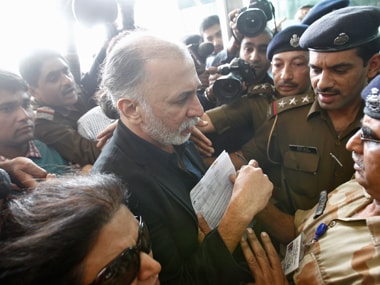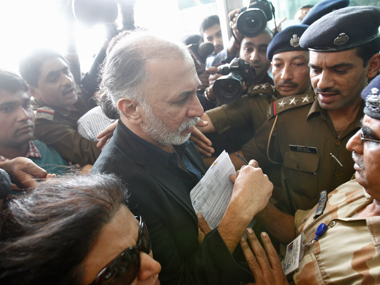This month’s issue of Outlook India magazine carries a long report titled ‘What The Elevator Saw’ containing detailed descriptions and illustrative graphics from the CCTV footage which throws light on rape charges made against former Tehelka editor-in-chief Tarun Tejpal by a reporter at Tehelka. Many journalists and commentators have already tweeted their conclusions that the CCTV footage does not quite support the victim’s complaint. As an illustration, read
here
,
here
and
here
. The Outlook report, however, is the first time detailed descriptions and graphics have been published based on the CCTV footage. The CCTV footage comprises a vital piece of evidence in the upcoming trial of Tejpal in the Panaji fast-track court. In February, the
court had permitted Tejpal
to have a copy of the CCTV footage, reportedly under strict conditions. However,
reports in the beginning of March
stated that Goa Police told the Bombay High Court that that Tejpal’s family was showing CCTV footage to “everyone”. Presumably, journalists, commentators and other celebrities who have spoken in support of Tejpal may also have seen the CCTV footage allegedly circulated by the Tejpal family. [caption id=“attachment_1398255” align=“alignleft” width=“380”] Tarun Tejpal in this file photo. Reuters[/caption] The Outlook report has taken the description to a higher level. As the Indian Express
reports, this has got the Goa Police activated who say they are examining the legal possibilities and will project “at the right platform at the right time.” The Goa Police say that the footage was made available to Tejpal under the strict condition that no portion thereof would be made public. Indeed, the most crucial purpose guiding that condition was that the victim’s identity be kept confidential. The lawyer appearing for Tejpal has said that there is no difficulty in viewing the underlying facts “so long as the identity is protected”. So, what are the different issues pertaining to the Outlook report that may be at play in courts? At the outset, the incident allegedly took place inside the elevator. There wasn’t any CCTV inside the lift. Therefore, the CCTV footage circulated does not contain any recording of what happened inside the elevator. In that sense, therefore, what happened outside the elevator (both when the two entered and exited) is critical and will primarily be deciphered from the CCTV footage. If Tejpal’s family is, indeed, responsible for dissemination of the CCTV footage, it hasn’t done Tejpal any favour by making it public. Secondly, the Goa Police and the prosecution would need to examine what the precise conditions in handing over Tejpal’s family the CCTV footage were. Was protecting the identity of the victim the sole condition of the court? Or, was the court’s condition broader, i e, that CCTV footage not be shared with anyone nor used for any purpose other than enabling Tejpal to prepare his legal defence? If it was the former, (i e, narrower condition), whether or not the identity of the victim is protected in the alleged distribution of CCTV footage to “everyone” is a big question. Is the victim blurred out in the footage so that her identity is kept protected? The Goa Police would certainly need to look into that. If it was the latter, then there may well be serious contempt of court if Tejpal or his family is responsible for dissemination. Thirdly, the Goa Police and the prosecution may also need to assess if
the recent Supreme Court guidelines on reporting sub-judice matters
provides the basis to seek an order for postponement of publication. Although the trial has not yet commenced, it is due to commence very soon. In a 1967 case [Naresh Shridhar Mirajkar v State of Maharashtra], a nine-judge Bench of SC upheld an HC decision which ordered that the deposition of the defence witness – a crucial piece of evidence – should not be reported in papers. SC upheld this saying that orders prohibiting publication for a temporary period were permissible under the inherent powers of the court if the court was satisfied that interest of justice requires that. More vitally, SC held that this prohibition did not offend the freedom of press since it was necessary to protect the interests of justice and administration of justice. Therefore, in the recent guidelines, SC has held that the right of a fair trial guaranteed under Article 21 was a valid restriction operating on the right to free speech of the media. There must be a “real and substantial risk” of prejudice to fairness of the trial or to the proper administration of justice if a court has to order postponement of publication. It is useful to note that courts in India have regarded the right to fair trial as a right available not just to the accused (i e Tejpal here), but also to the victim. Indeed, prejudice to the fairness of the trial may, at times, affect the victim much more than the accused. What then is the “real and substantial risk” of prejudice to fairness of trial that may arise due to graphic illustrations of some aspects of the CCTV footage in the Outlook story? Does interest of justice require temporary postponement of publication of that story or any other story describing what is in the CCTV footage? A case can well be made out. As the SC guidelines indicate, “excessive prejudicial publicity leading to usurpation of functions of the court not only interferes with administration of justice … it also prejudices or interferes with a particular legal proceeding”. Subjecting the victim to excess and undue publicity in media by prejudging what that vital piece of evidence contains and simultaneously calling into question the character of the victim/complainant even before she faces grilling by the defence, even if indirectly, may well amount to being a real and substantial risk of prejudice. In any other crime, this may not be a highly significant issue. But, in the case of an alleged sexual assault (and, indeed, rape under the new definition), it is extremely difficult for the victim to appear in court and stand up to the cross-questioning in the first place. Whether the Goa Police and the prosecution take legal recourse against the dissemination of CCTV footage and publication based on it, and, if so, how the courts in Goa approach this, will have far-reaching consequences on critical matters affecting the pursuit of rape cases in our country. The ball is now in the court of our criminal justice system.
Tarun Tejpal in this file photo. Reuters[/caption] The Outlook report has taken the description to a higher level. As the Indian Express
reports, this has got the Goa Police activated who say they are examining the legal possibilities and will project “at the right platform at the right time.” The Goa Police say that the footage was made available to Tejpal under the strict condition that no portion thereof would be made public. Indeed, the most crucial purpose guiding that condition was that the victim’s identity be kept confidential. The lawyer appearing for Tejpal has said that there is no difficulty in viewing the underlying facts “so long as the identity is protected”. So, what are the different issues pertaining to the Outlook report that may be at play in courts? At the outset, the incident allegedly took place inside the elevator. There wasn’t any CCTV inside the lift. Therefore, the CCTV footage circulated does not contain any recording of what happened inside the elevator. In that sense, therefore, what happened outside the elevator (both when the two entered and exited) is critical and will primarily be deciphered from the CCTV footage. If Tejpal’s family is, indeed, responsible for dissemination of the CCTV footage, it hasn’t done Tejpal any favour by making it public. Secondly, the Goa Police and the prosecution would need to examine what the precise conditions in handing over Tejpal’s family the CCTV footage were. Was protecting the identity of the victim the sole condition of the court? Or, was the court’s condition broader, i e, that CCTV footage not be shared with anyone nor used for any purpose other than enabling Tejpal to prepare his legal defence? If it was the former, (i e, narrower condition), whether or not the identity of the victim is protected in the alleged distribution of CCTV footage to “everyone” is a big question. Is the victim blurred out in the footage so that her identity is kept protected? The Goa Police would certainly need to look into that. If it was the latter, then there may well be serious contempt of court if Tejpal or his family is responsible for dissemination. Thirdly, the Goa Police and the prosecution may also need to assess if
the recent Supreme Court guidelines on reporting sub-judice matters
provides the basis to seek an order for postponement of publication. Although the trial has not yet commenced, it is due to commence very soon. In a 1967 case [Naresh Shridhar Mirajkar v State of Maharashtra], a nine-judge Bench of SC upheld an HC decision which ordered that the deposition of the defence witness – a crucial piece of evidence – should not be reported in papers. SC upheld this saying that orders prohibiting publication for a temporary period were permissible under the inherent powers of the court if the court was satisfied that interest of justice requires that. More vitally, SC held that this prohibition did not offend the freedom of press since it was necessary to protect the interests of justice and administration of justice. Therefore, in the recent guidelines, SC has held that the right of a fair trial guaranteed under Article 21 was a valid restriction operating on the right to free speech of the media. There must be a “real and substantial risk” of prejudice to fairness of the trial or to the proper administration of justice if a court has to order postponement of publication. It is useful to note that courts in India have regarded the right to fair trial as a right available not just to the accused (i e Tejpal here), but also to the victim. Indeed, prejudice to the fairness of the trial may, at times, affect the victim much more than the accused. What then is the “real and substantial risk” of prejudice to fairness of trial that may arise due to graphic illustrations of some aspects of the CCTV footage in the Outlook story? Does interest of justice require temporary postponement of publication of that story or any other story describing what is in the CCTV footage? A case can well be made out. As the SC guidelines indicate, “excessive prejudicial publicity leading to usurpation of functions of the court not only interferes with administration of justice … it also prejudices or interferes with a particular legal proceeding”. Subjecting the victim to excess and undue publicity in media by prejudging what that vital piece of evidence contains and simultaneously calling into question the character of the victim/complainant even before she faces grilling by the defence, even if indirectly, may well amount to being a real and substantial risk of prejudice. In any other crime, this may not be a highly significant issue. But, in the case of an alleged sexual assault (and, indeed, rape under the new definition), it is extremely difficult for the victim to appear in court and stand up to the cross-questioning in the first place. Whether the Goa Police and the prosecution take legal recourse against the dissemination of CCTV footage and publication based on it, and, if so, how the courts in Goa approach this, will have far-reaching consequences on critical matters affecting the pursuit of rape cases in our country. The ball is now in the court of our criminal justice system.
CCTV footage of Tarun Tejpal case: The legal issues at play
Kartikeya
• April 2, 2014, 15:57:40 IST
What are the different issues pertaining to the Outlook report that may be at play in courts?
Advertisement
)
End of Article